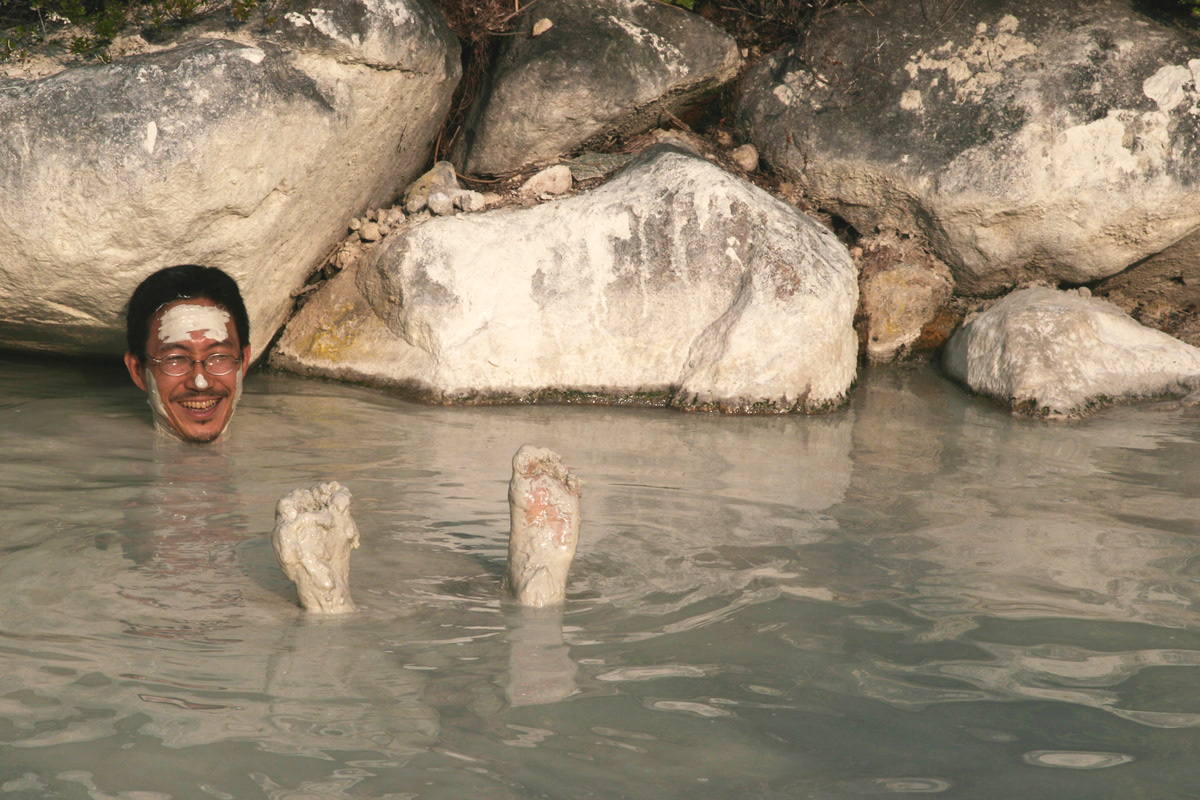
Chinoike or "blood pond hell" features a pond of hot, red water. It is one of the most photogenic of the nine Beppu hells.

Oniishibozu Hell Jigoku - This hell is named after the mud bubbles, which emerge from boiling mud pools and look like the shaven heads of monks. This is one of the more striking and unique of all the "hells" of Beppu.

Shiraike Jigoku - as its name suggests, "white pond hell" features a pond of hot, milky white water.

Sand Bath at Beppu - in addition to all the natural hot thermal water baths of Beppu there are also sand baths and even mud baths to help open the pores. Sand Bath at Beppu - in addition to all the natural hot thermal water baths of Beppu are unusual sand baths and even mud baths. The Beppu sand bath is conveniently located on Shoningahama Beach. Sand Bath at Beppu - A group of friends or family can enjoy being immersed in the hot sand bath together. A distinctly unique experience, having to have a bath after your sand bath to get rid of the sand. Still, the experience will ease the muscles by sinking in the warm sand while gazing over the vast, blue ocean

Japanese woman being buried in sand bath at Beppu, one of the few places in Japan where sand is used for spa treatments. Beppu's sand bath is conveniently located on Shoningahama Beach

Kamado Jigoku or the "cooking pot hell" features several boiling ponds and a fierce or is that kitsch demon statue as cook.

Onsen Hoyo Land is famous for its unique open air mud baths, one of the only mud baths available for bathing in Japan. This mud bath is mixed with male and female bathers.

Foot baths are all the rage in Japan, often in front of railway stations in hot spring towns to give tired travelers a rest from their arduous sightseeing schedules.

Japanese Straw Sandals - Zori are flat and thonged Japanese sandals made of rice straw or other plant fibers. Cloth, lacquered wood, leather, rubber and increasingly synthetic materials are used for the modern version of what we know as flip-flops.

Monju Temple Boddhisatvas - Moss Covered Jizos - "Jizo" images and statues are popular in Japan as Bodhisattva who console beings awaiting rebirth and travelers. As such they are often found along roadsides, paths or even street corners.

Onsen Eggs - Onsen eggs are cooked in hot springs. Since the eggs are slowly cooked in hot water of about 70-75 Celsius (158-167 Fahrenheit), the egg whites are soft and egg yolks are slightly hardened. Onsen tamago is sometimes served as part of a Japanese style breakfast in hot springs towns. Otherwise, it is a snack for sale on the streets of these towns.

Kurokawa Onsen Rotemburo - Considered one of the best onsen villages in Japan Kurokawa is everything a spa town should be without the usual accompanying kitsch or ugliness. It's well known so you certainly won't be alone, but this low key resort still seems like a tiny, forgotten village out in the countryside of Japan.

Sashimi often is the first course in a formal Japanese meal, but can also be the main course, presented with rice and Miso soup in separate bowls. Many Japanese people believe that sashimi, traditionally considered the finest dish in Japanese cuisine, should be eaten before other strong flavors affect the palate. Culinarily, sashimi represents the Japanese cultural appreciation of subtlety.

Onsen Yukatas - Yukata is a Japanese summer robe. People wearing yukata are a common sight at fireworks displays, bon odori festivals and often worn after bathing at traditional Japanese inns. Though their use is not limited to after bath wear, yukata literally means "bath clothes".
